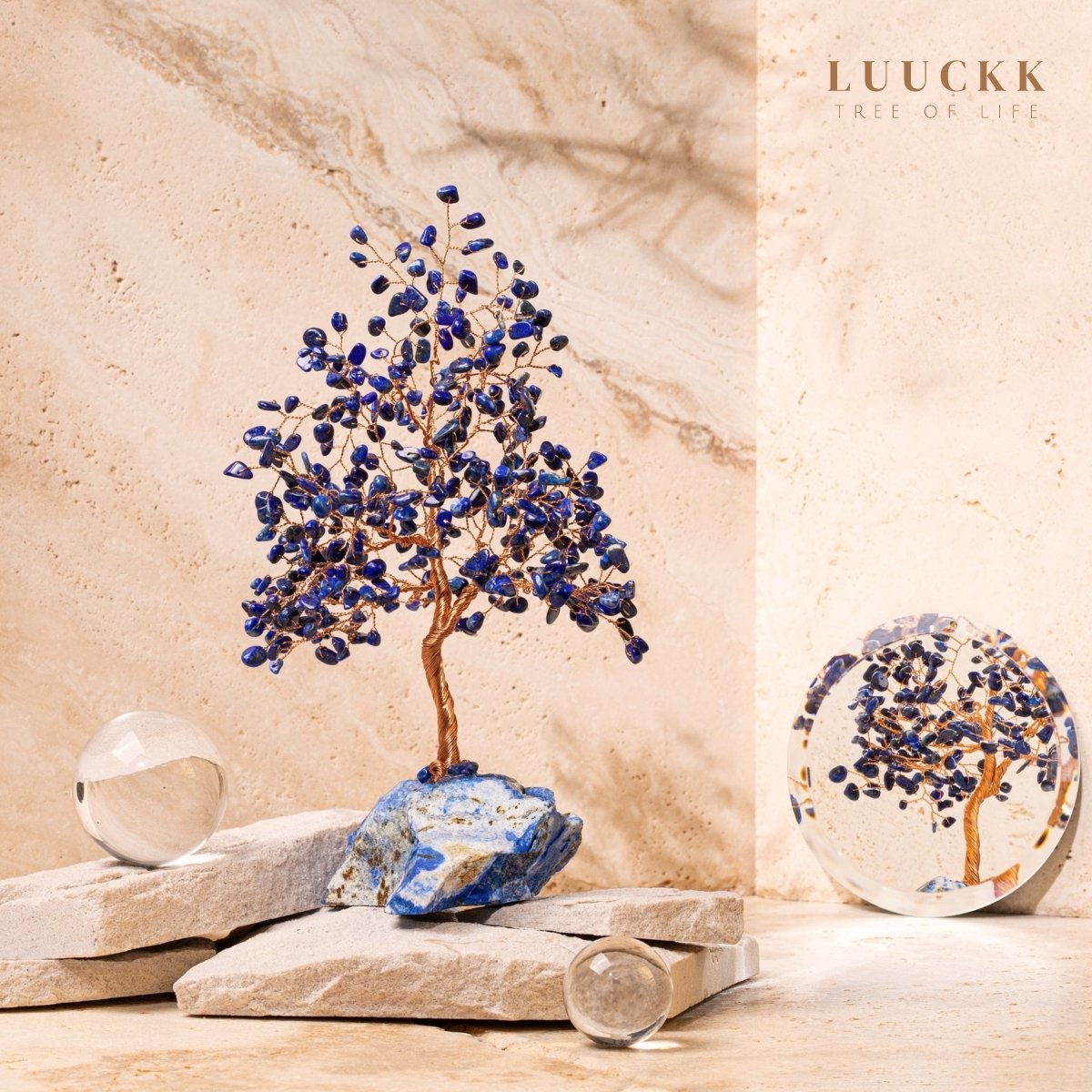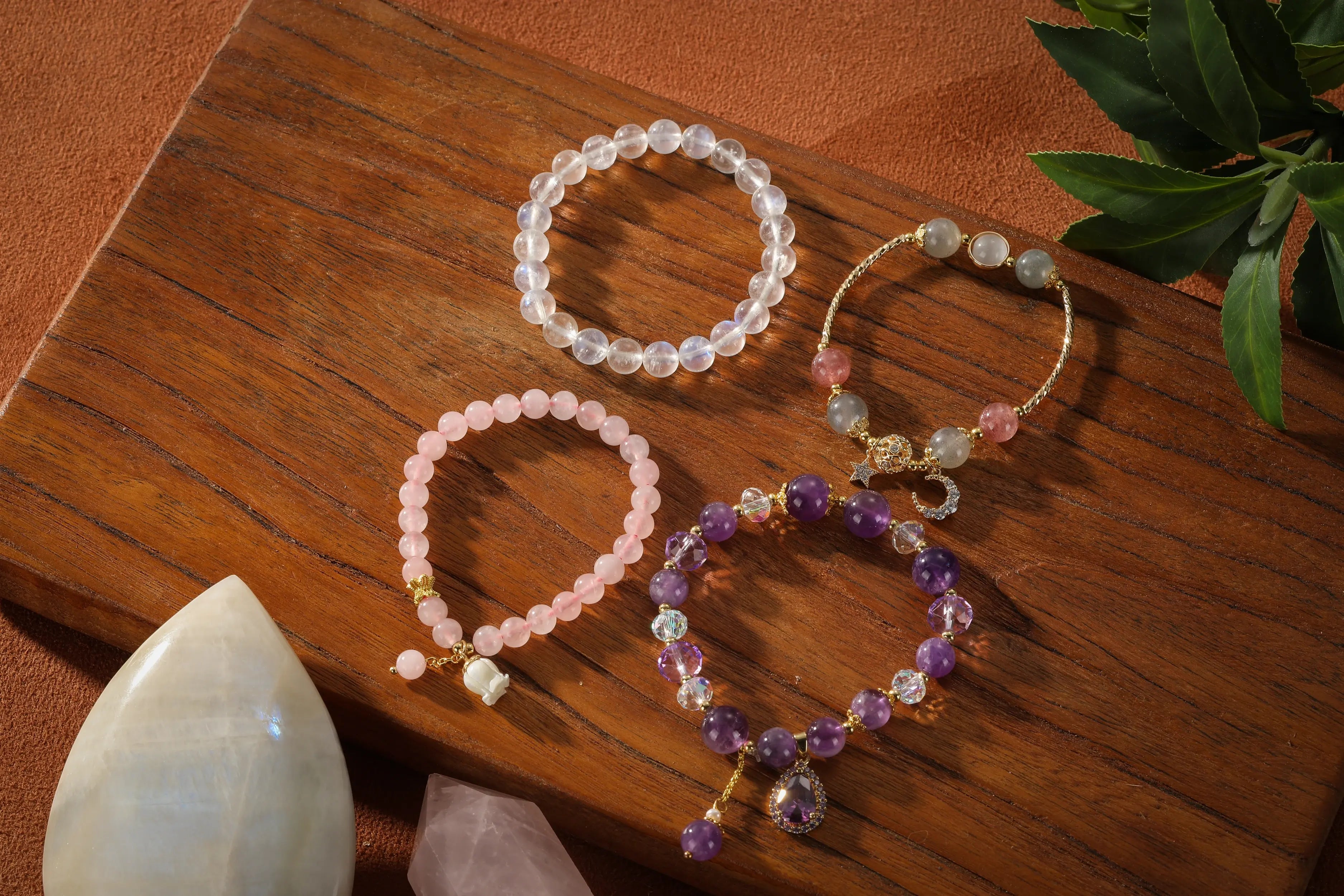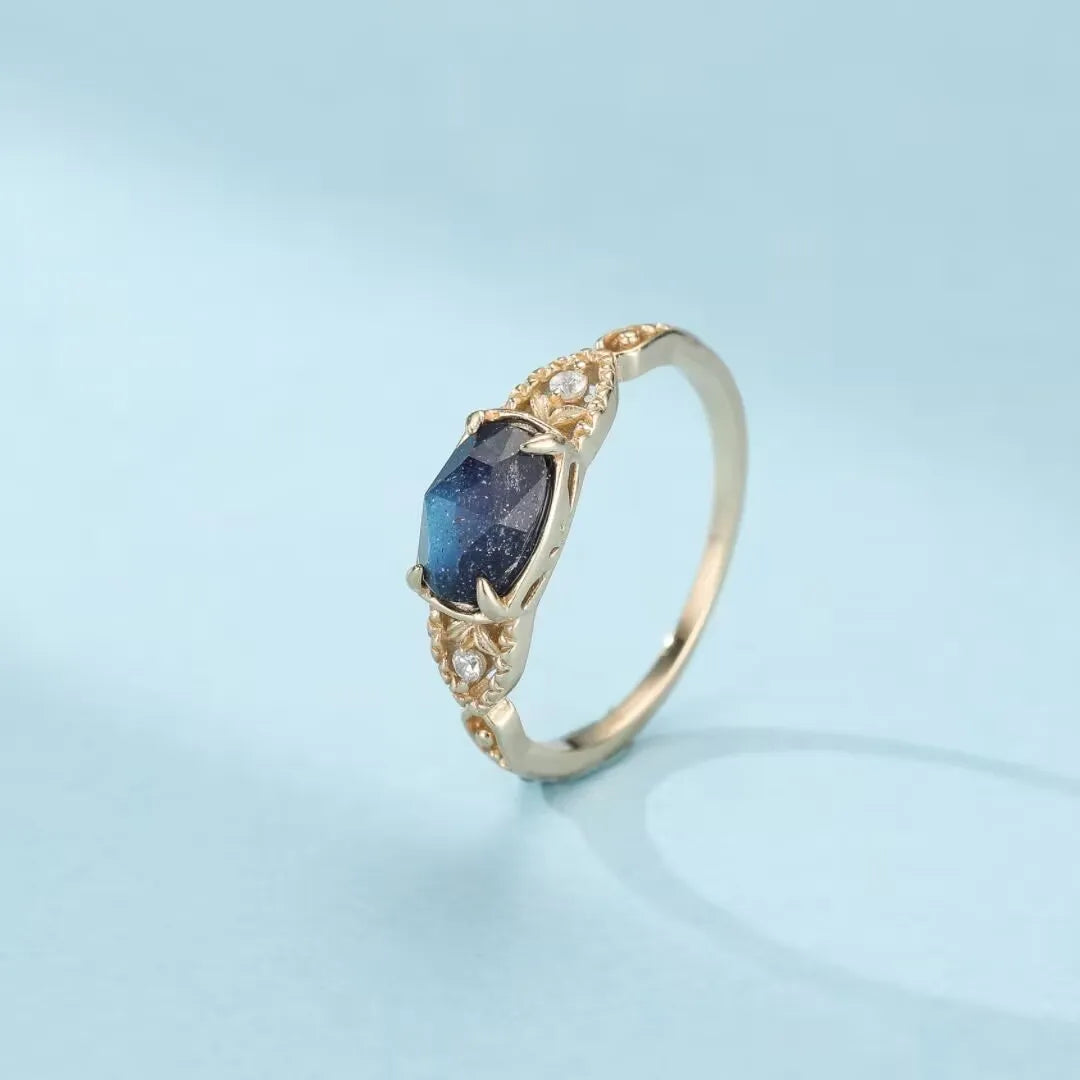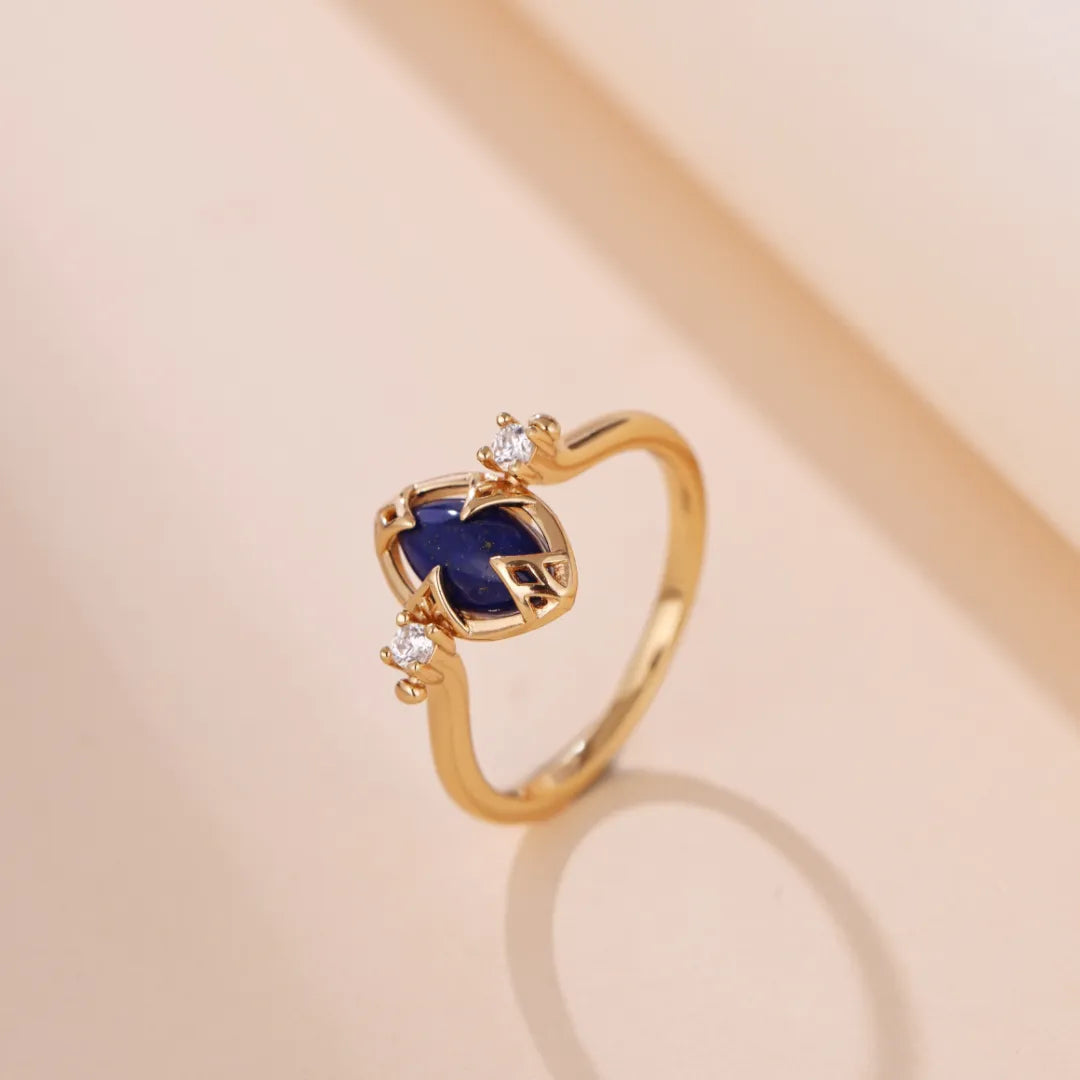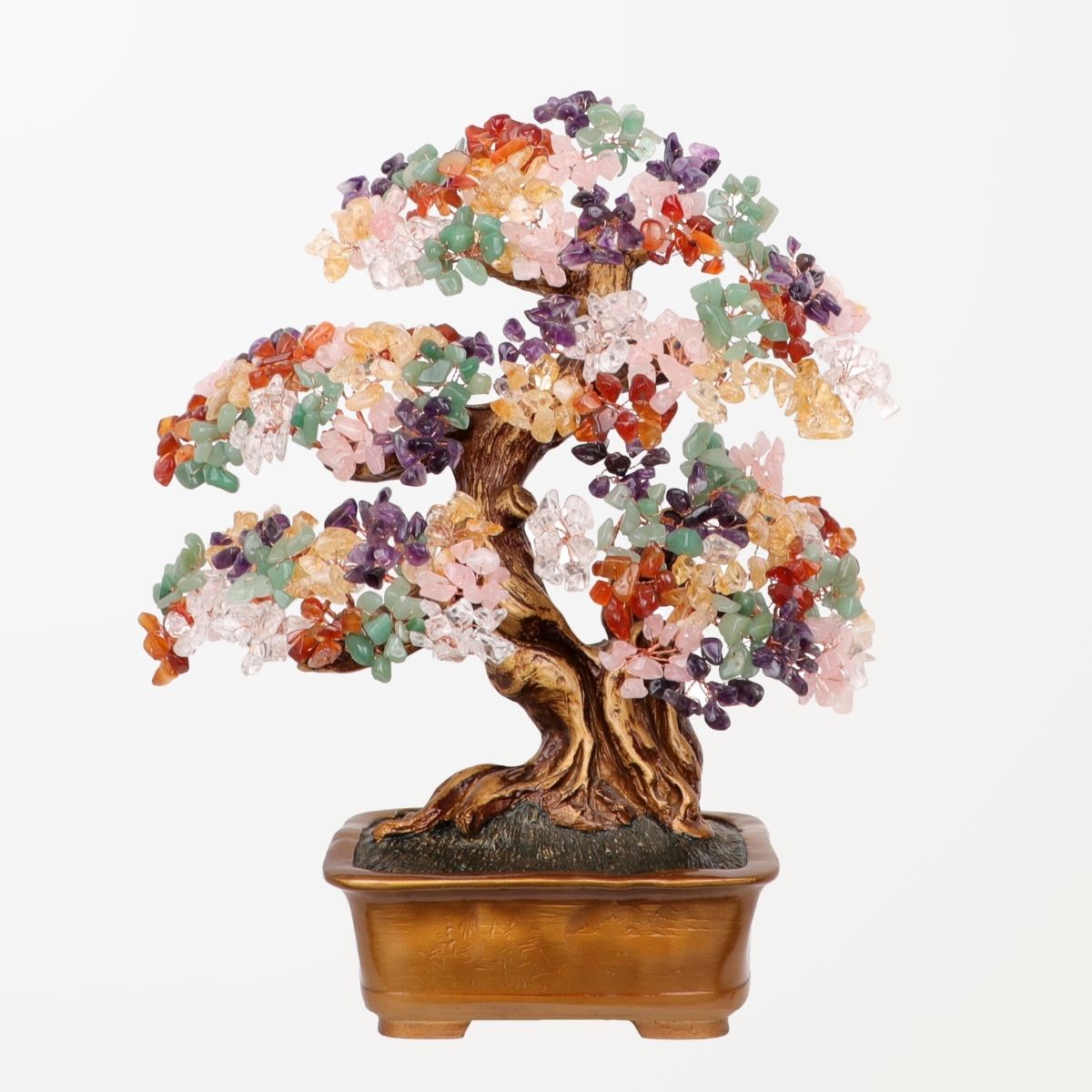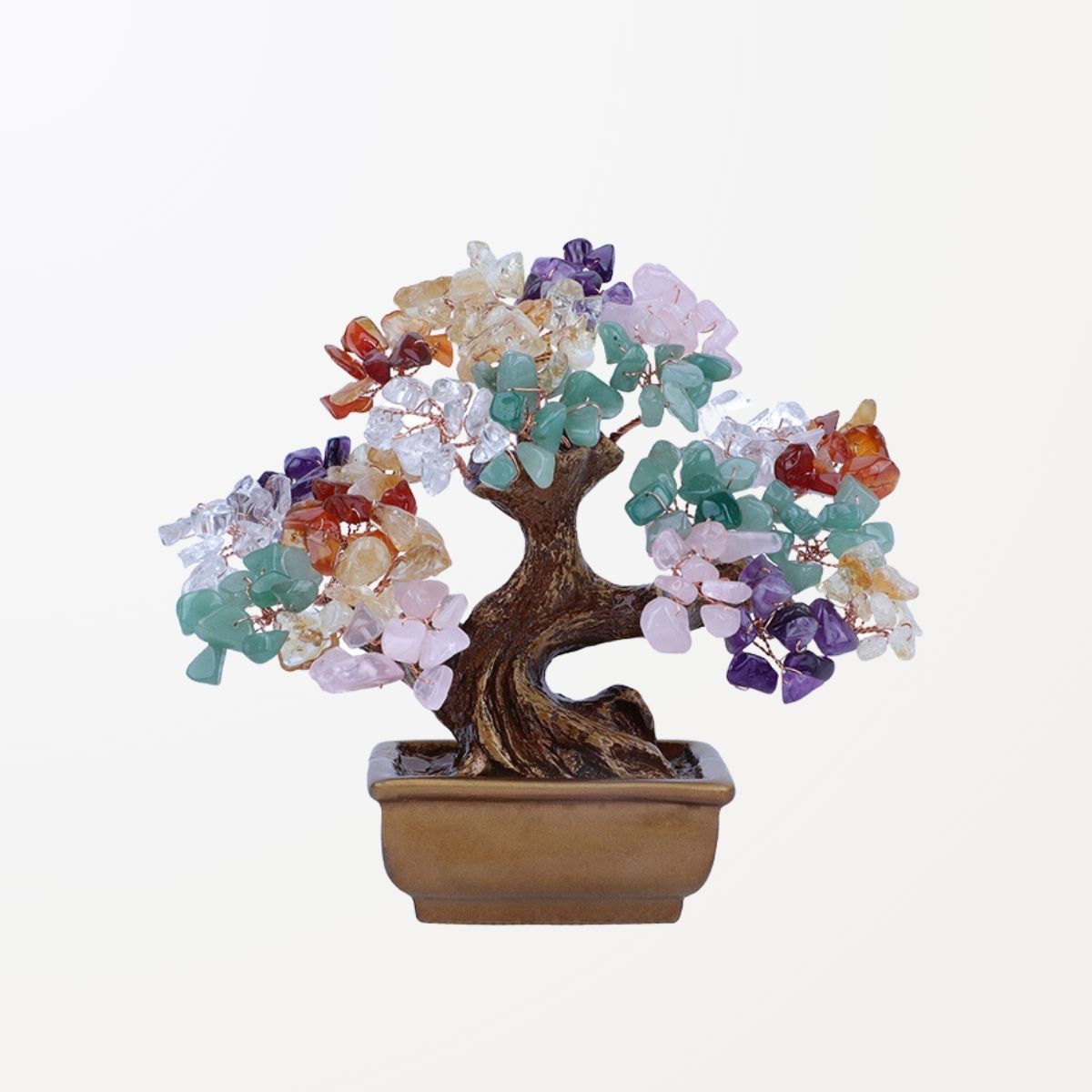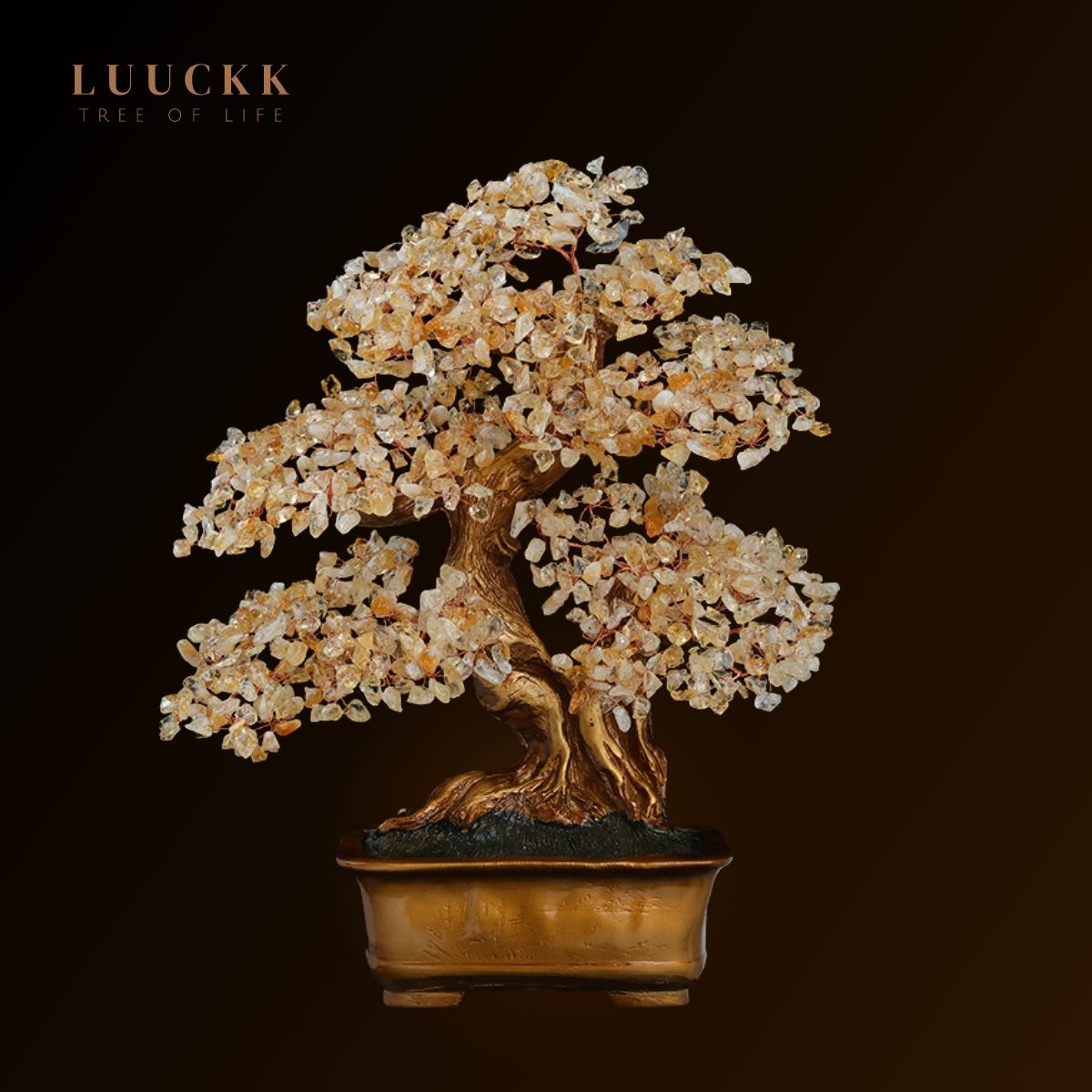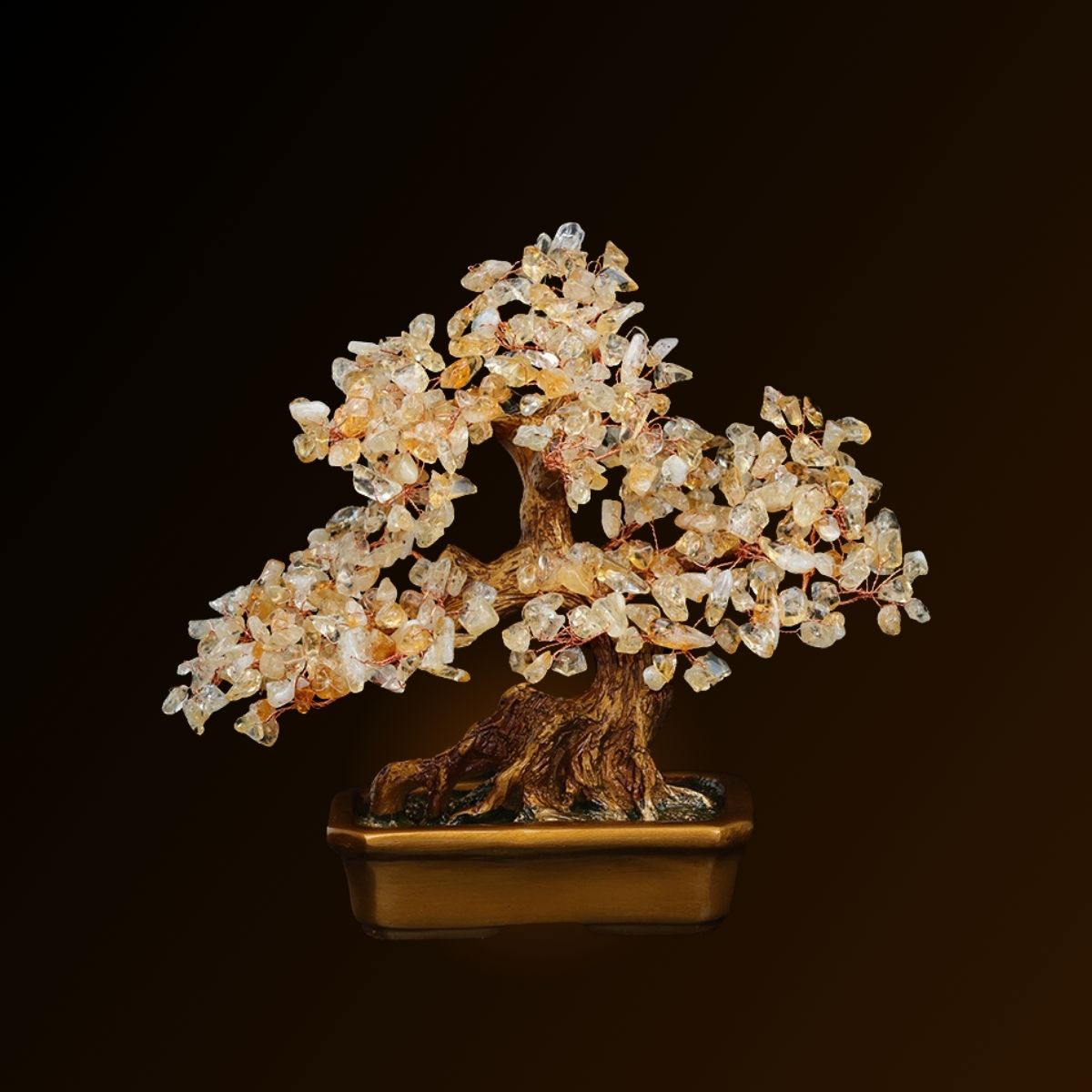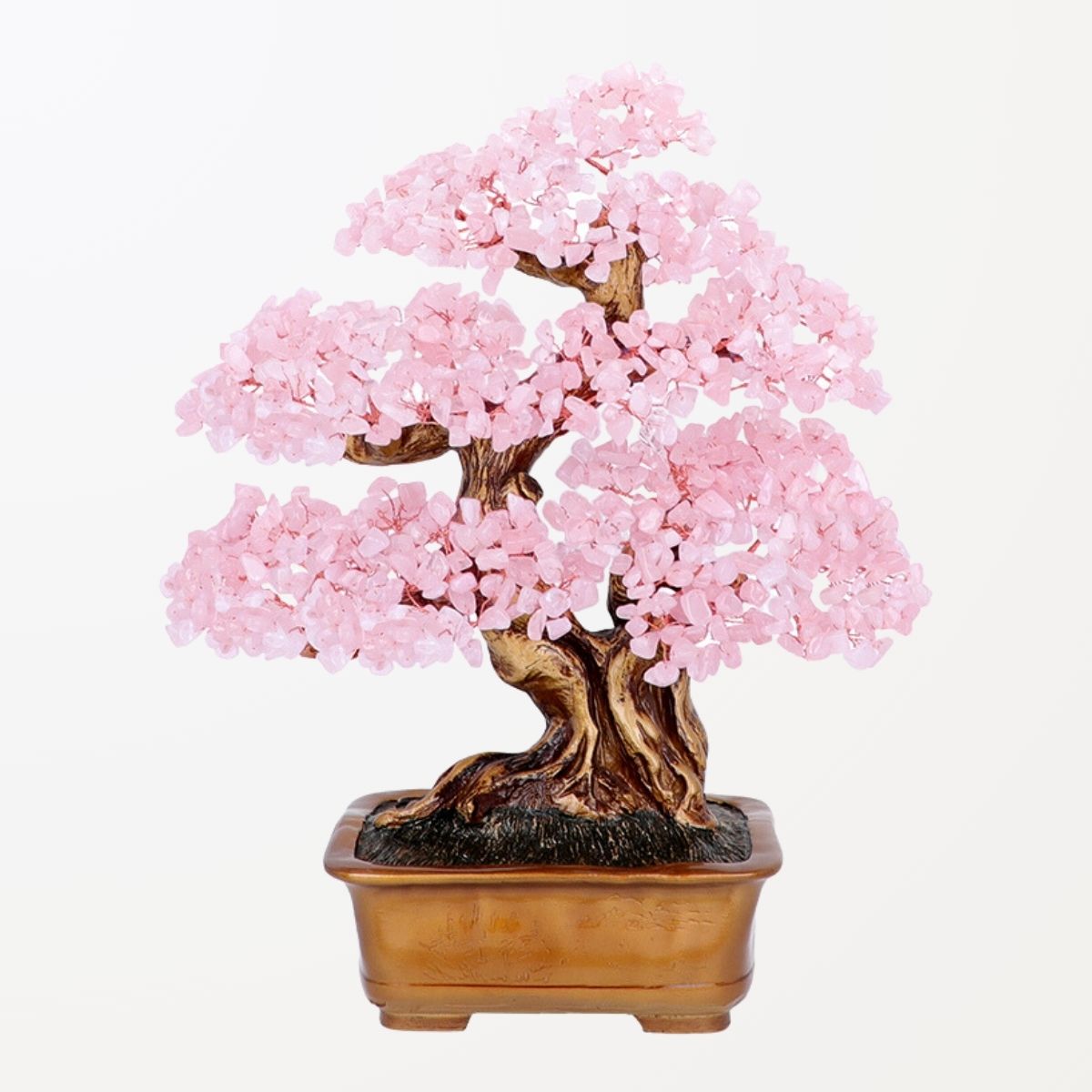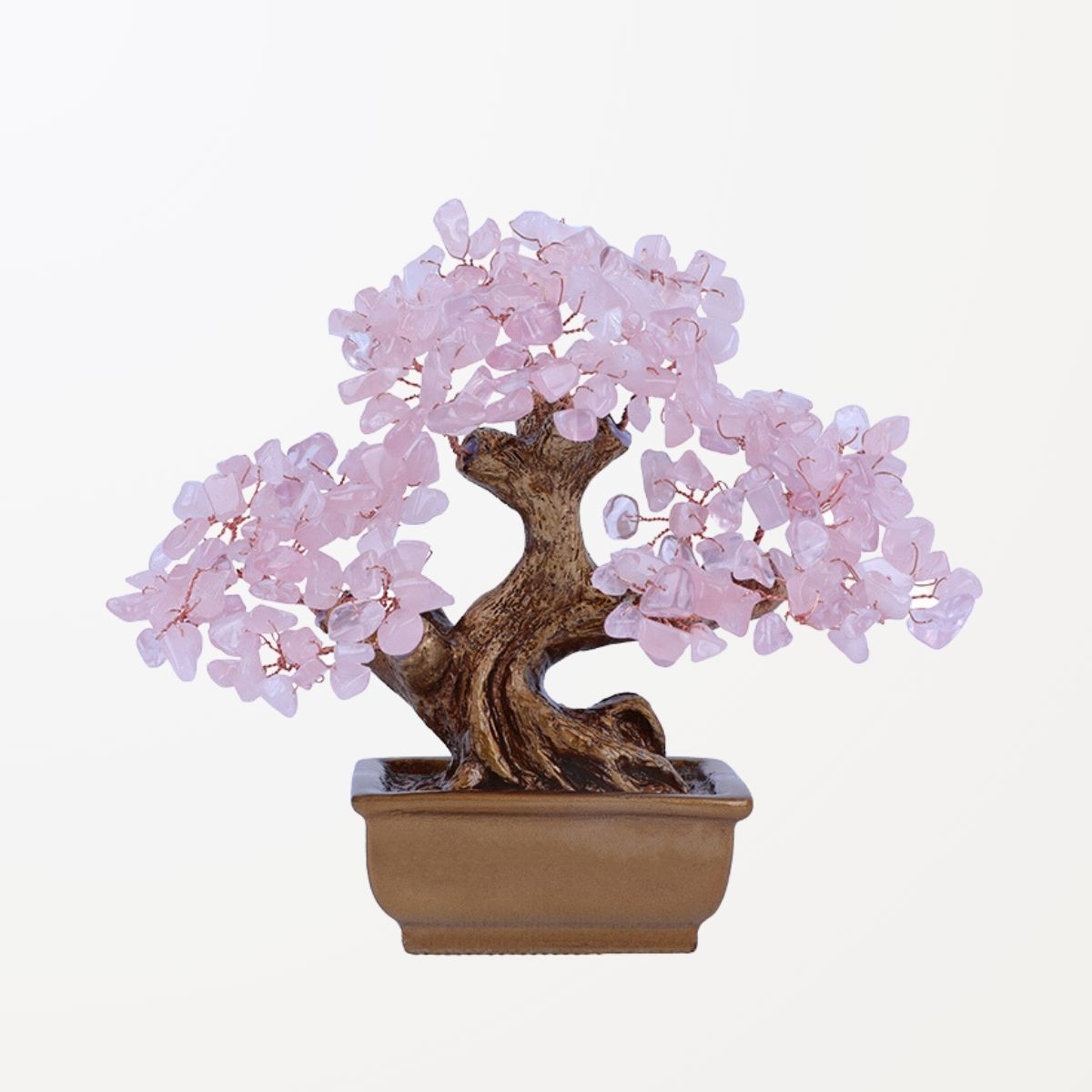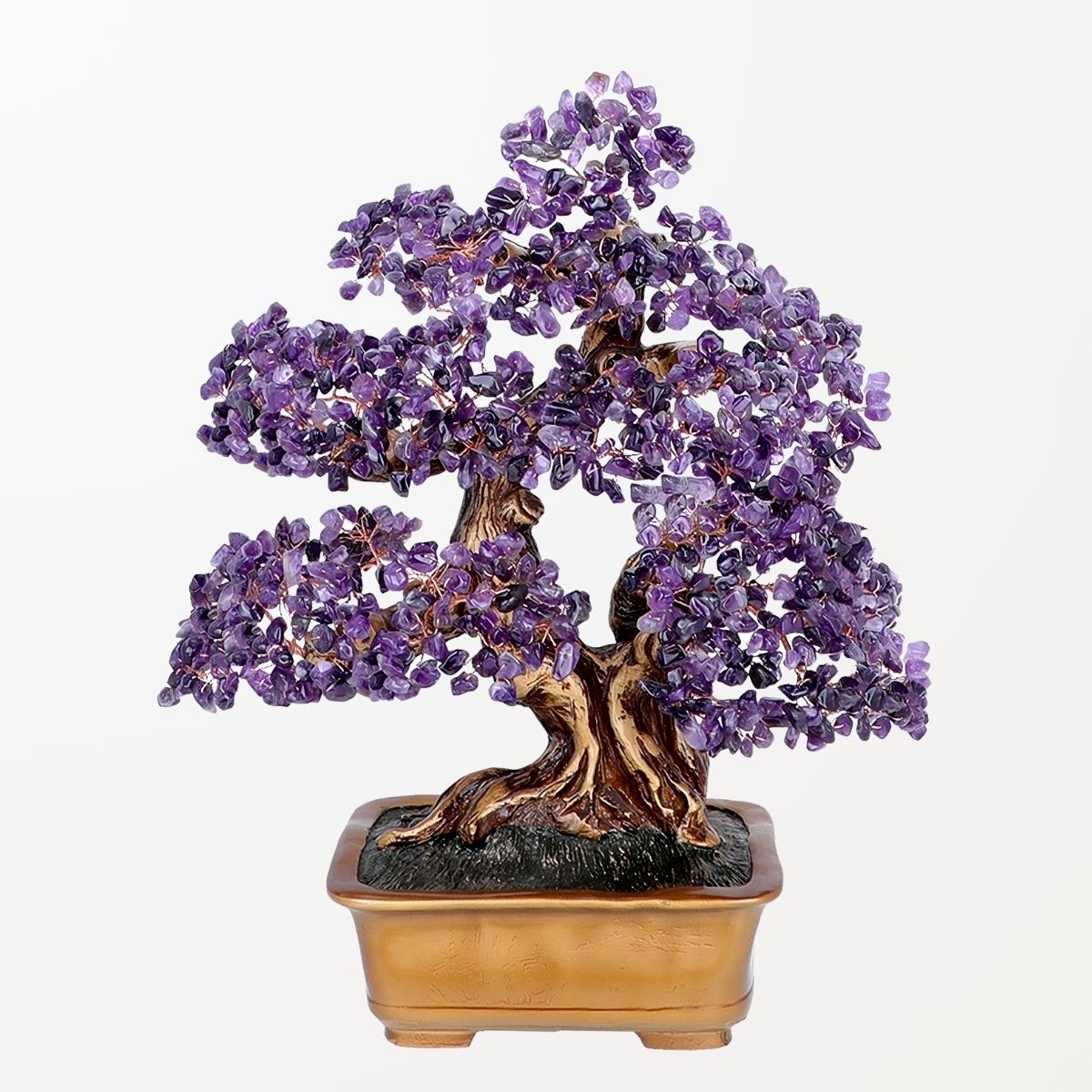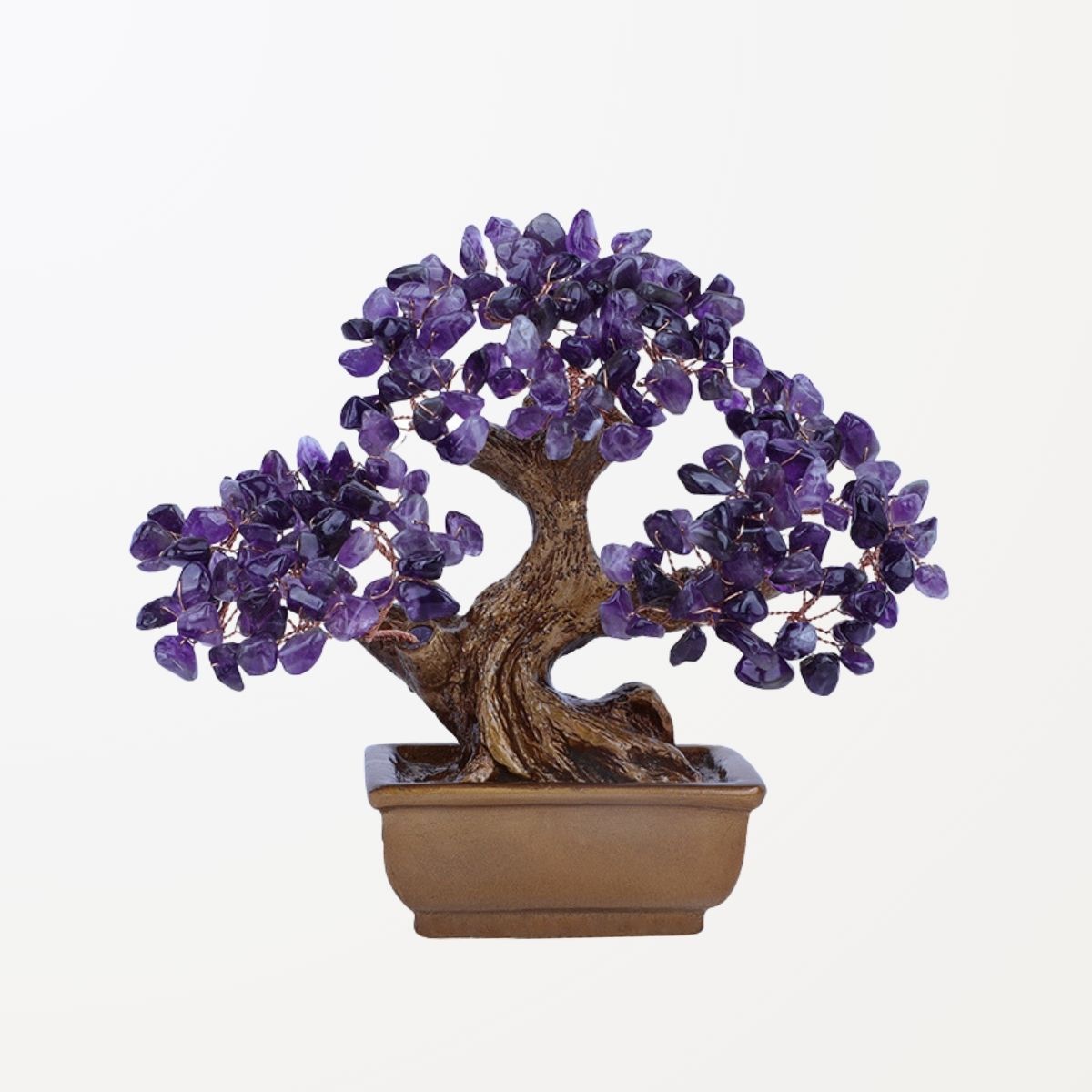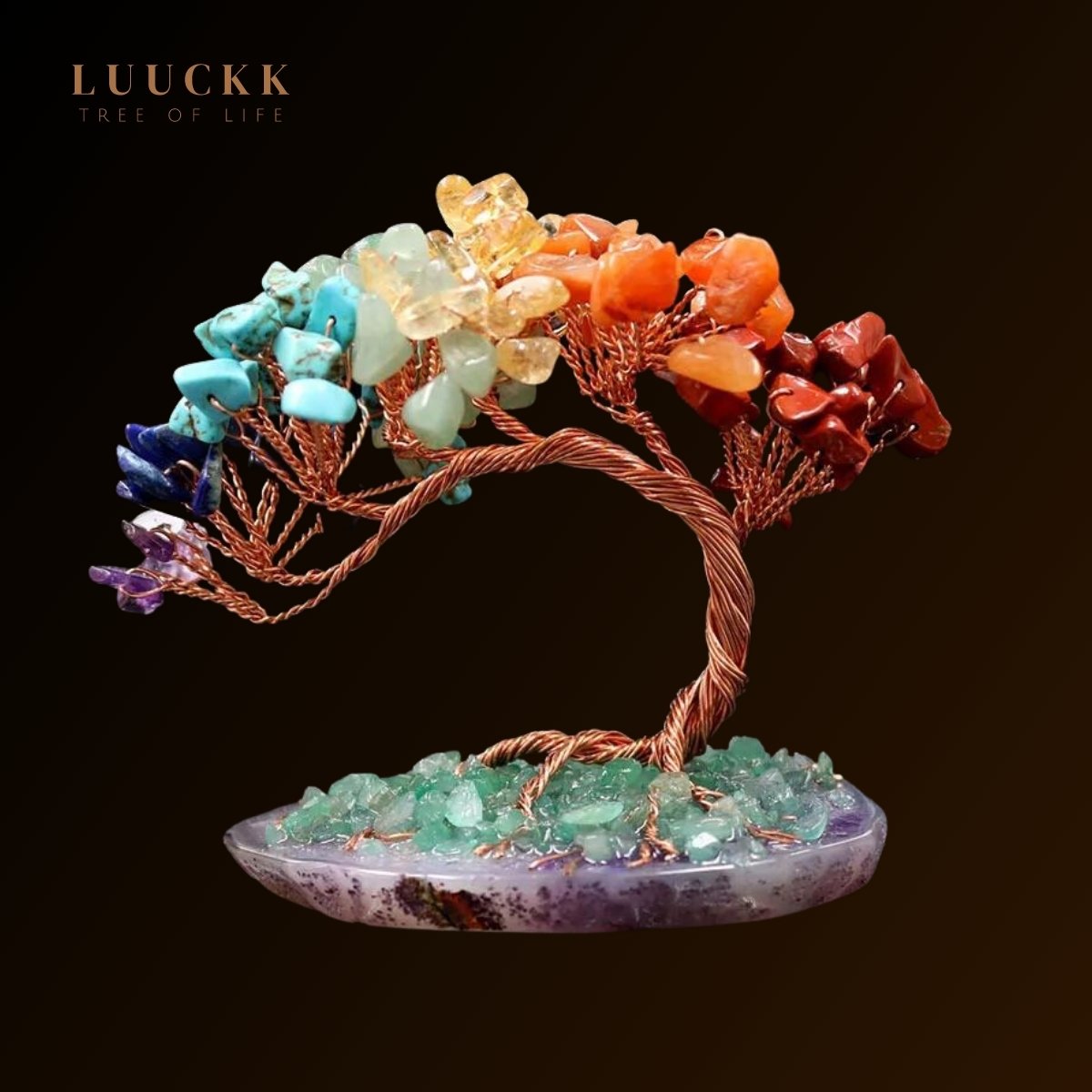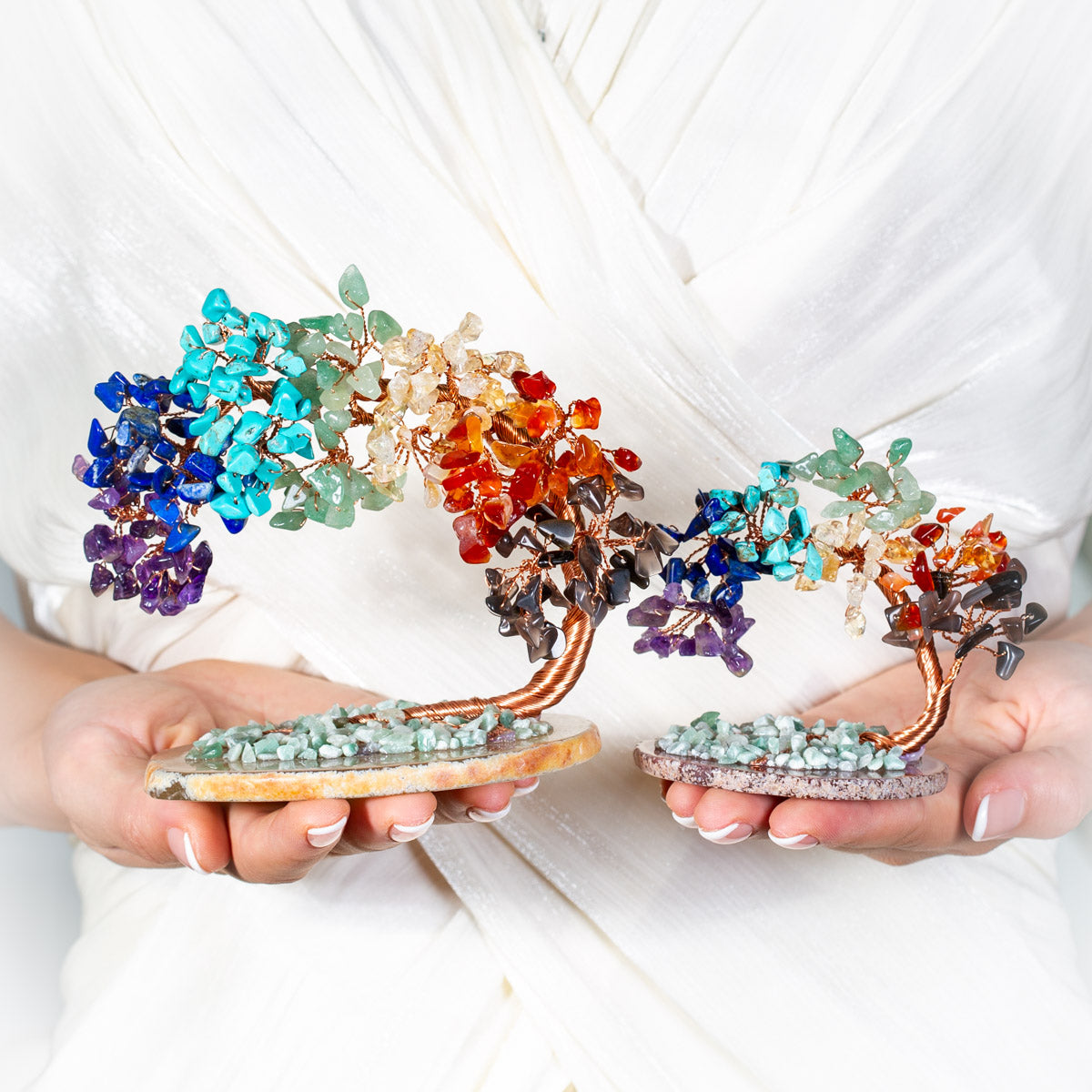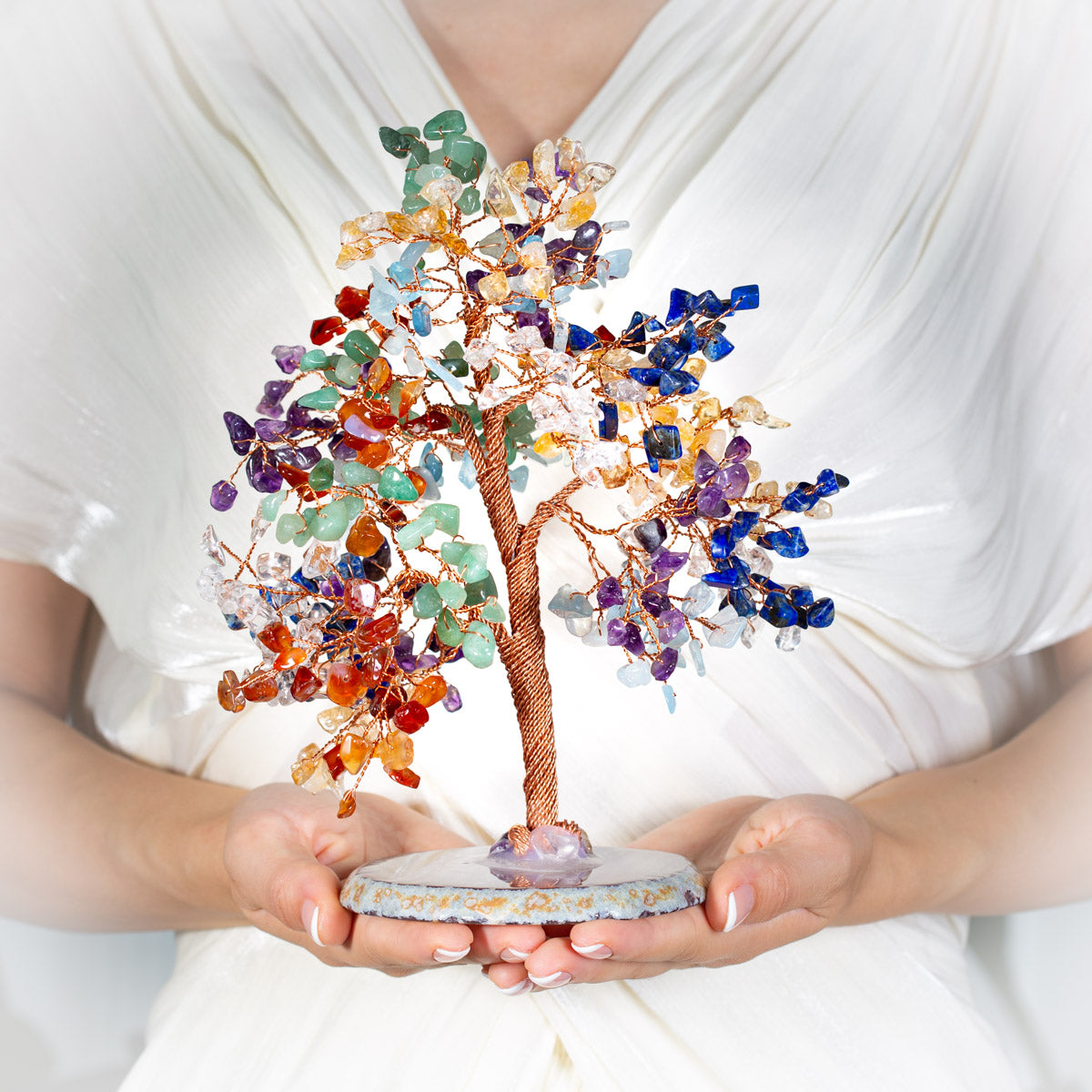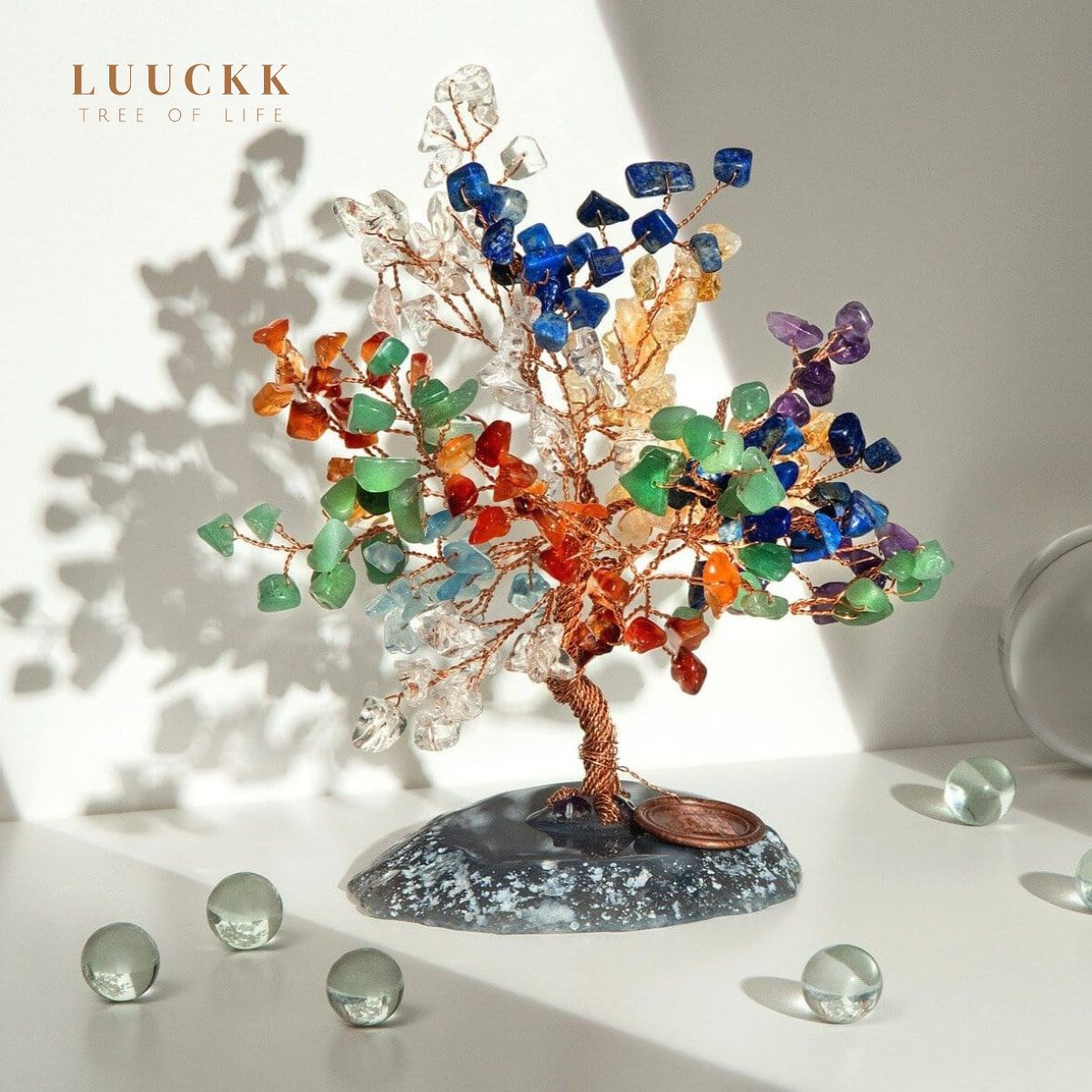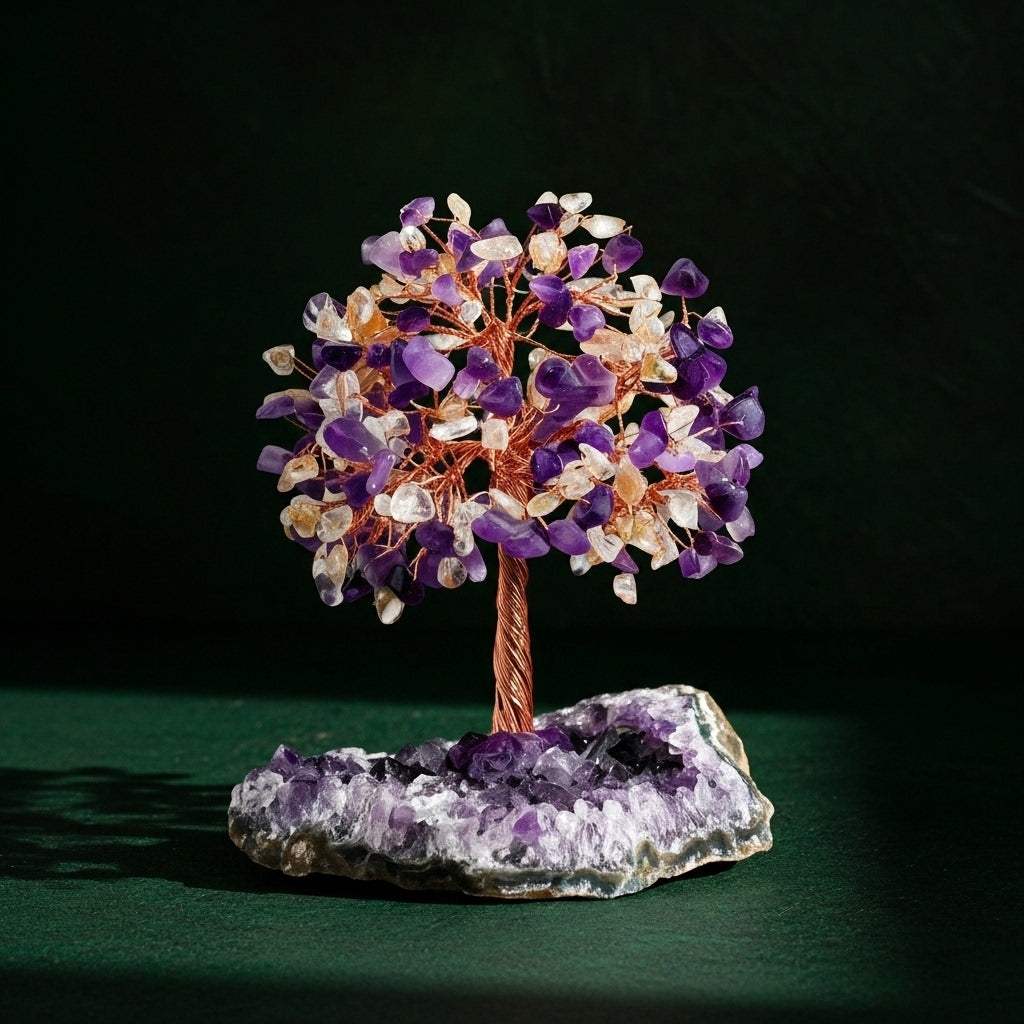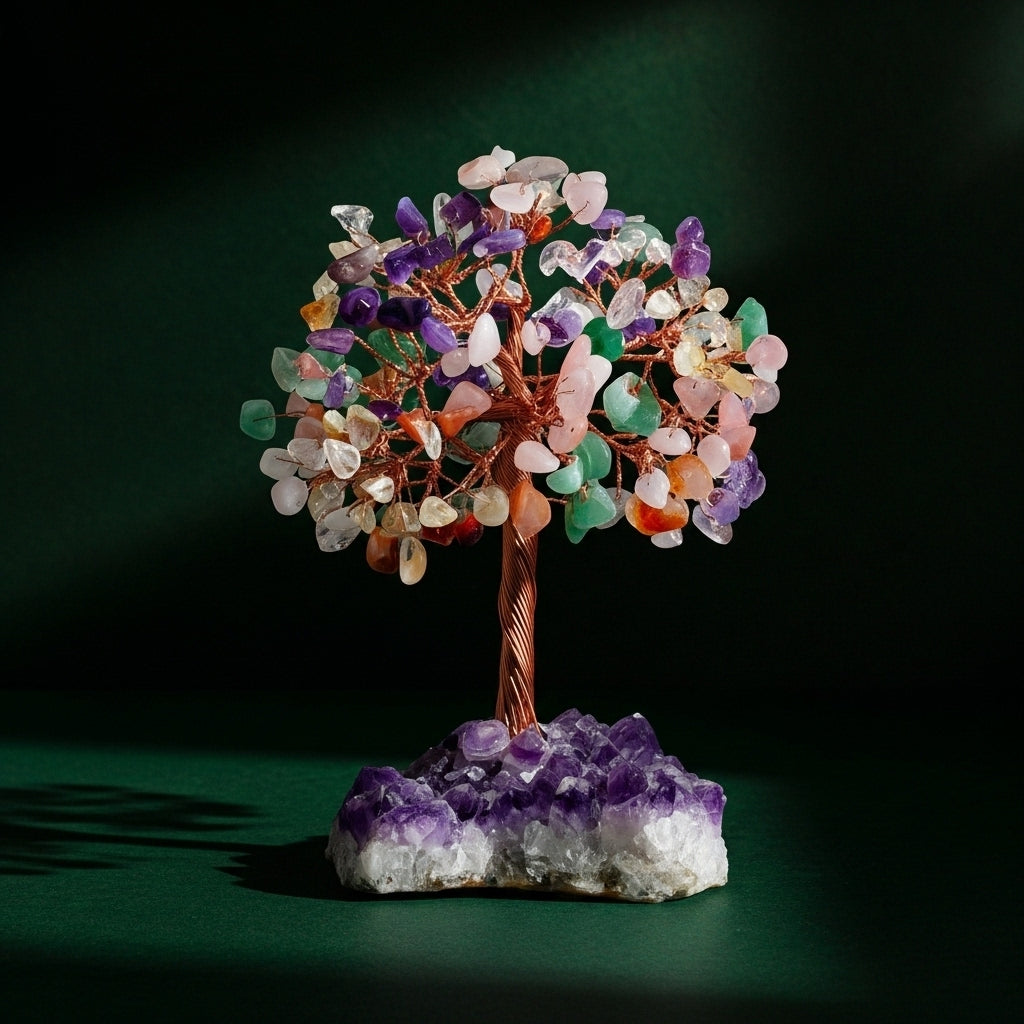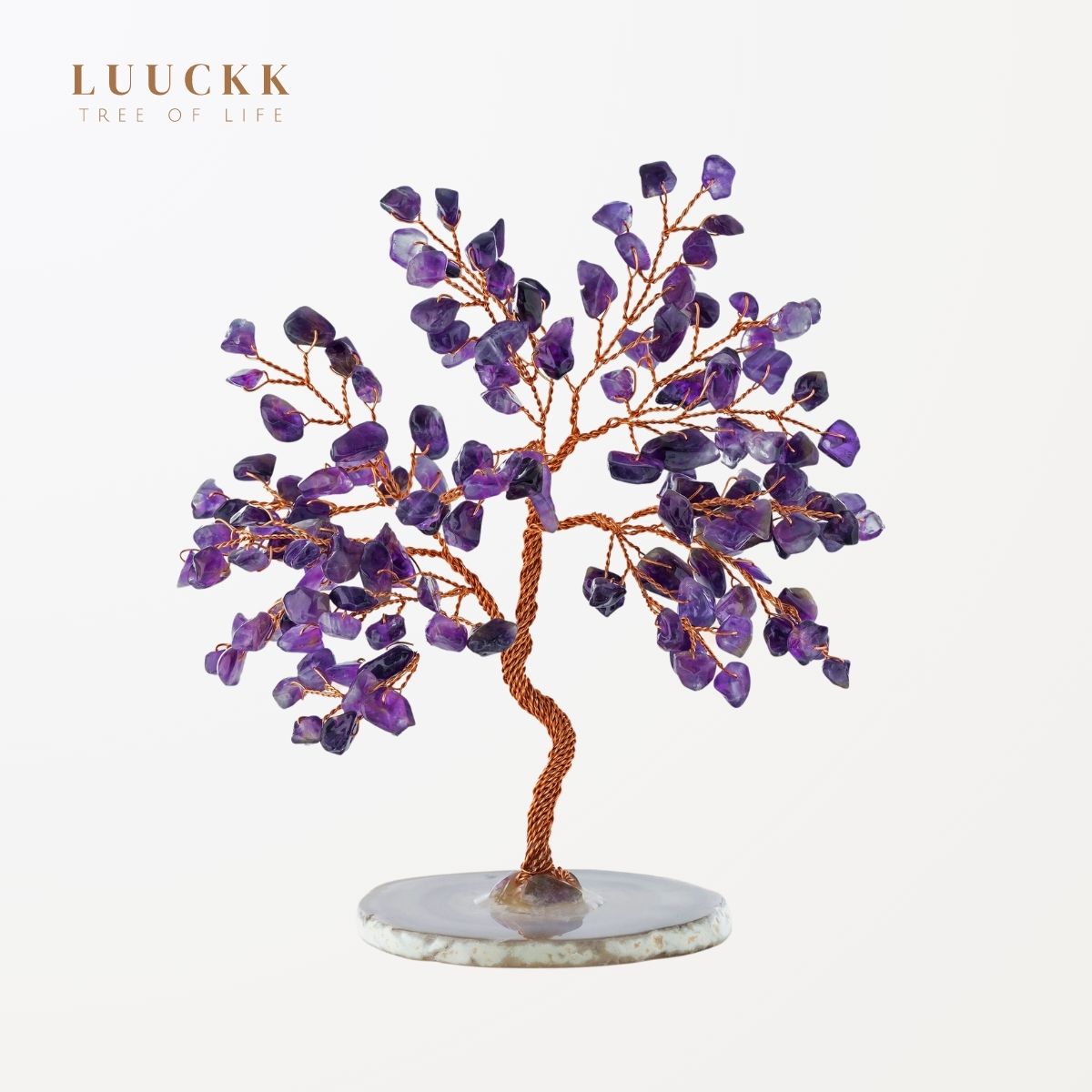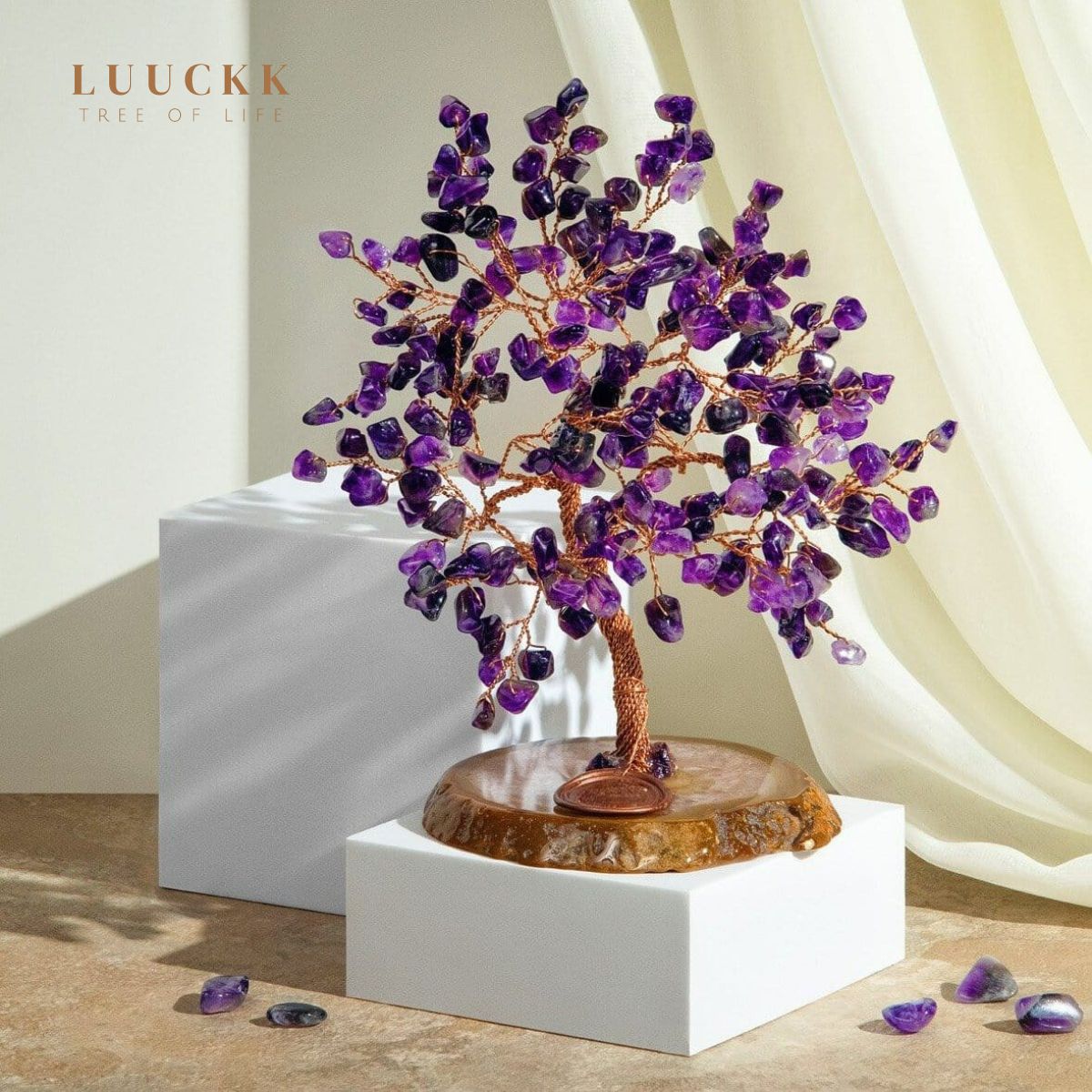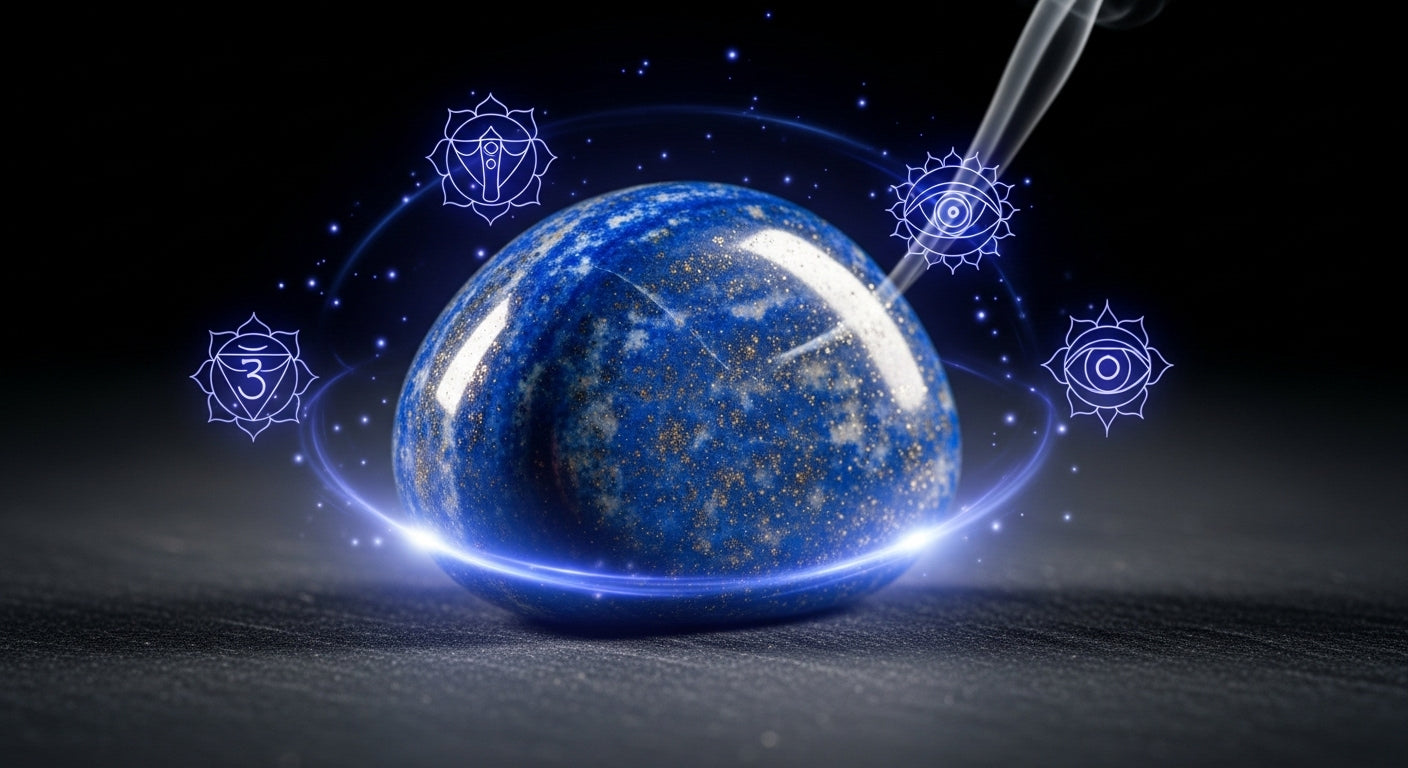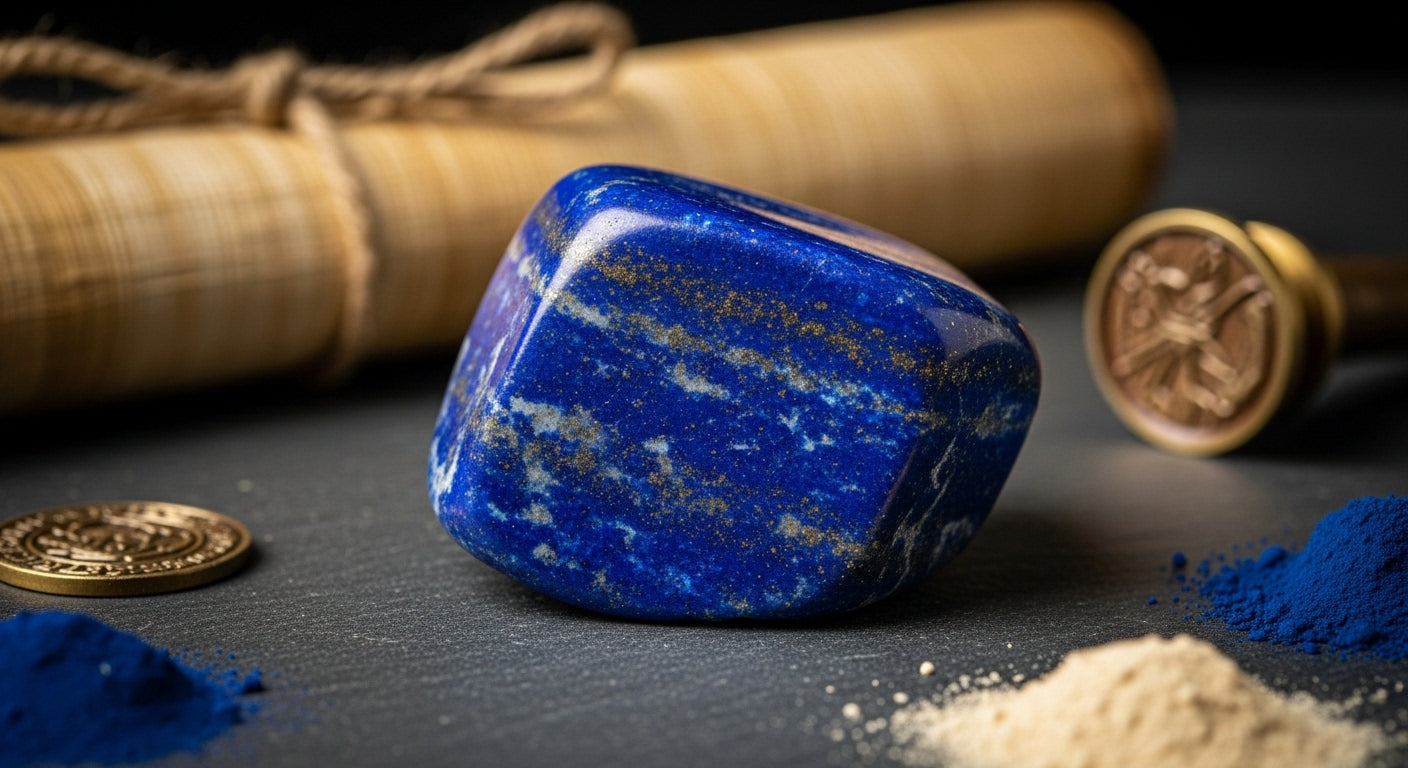
The Fascinating History of Lapis Lazuli: A Royal and Spiritual Stone
For millennia, natural stones have fascinated humanity with their beauty and mysterious virtues. Among them, lapis lazuli stands out with its deep blue color, often speckled with golden pyrite flecks, evoking a starry sky. This precious stone is not just an ornament: it has transcended ages, symbolizing wisdom, power, and spirituality.
From Egyptian pharaohs to Renaissance artists, including shamans and astrologers, lapis lazuli has left its mark on human history. But what does this stone really conceal? What are its secrets? Let’s delve into its fascinating history and discover how it can enrich our daily lives.
The Origins of Lapis Lazuli: A Precious Stone with a Millennia-Old History
An Ancient Treasure of Early Civilizations
Lapis lazuli is one of the oldest and most fascinating natural stones known to humanity. Its use dates back more than 7,000 years, long before the rise of the great civilizations we know today. Unlike other gemstones prized for their brilliance, lapis lazuli captivates with its deep blue hue, resembling a night sky filled with stars thanks to the golden pyrite inclusions it contains.
The First Mines: An Afghan Exclusive
The first known source of lapis lazuli is Afghanistan, specifically the Badakhshan mines, located in steep, hard-to-reach mountains. These mines, active for over 6,000 years, remain one of the world's primary sources of this precious stone. Mining flourished there as early as the Sumerian and Egyptian eras, with lapis lazuli being transported over long distances via ancient trade routes.
It is fascinating to note that despite civilization's evolution, these mines remain the most coveted for their exceptional-quality lapis lazuli. At the time, extracting it required perilous expeditions into remote mountains, and only rulers and elites could afford to acquire this extraordinary stone.
Lapis Lazuli in Antiquity: The Stone of Gods and Kings
Since antiquity, lapis lazuli has been a symbol of power, wisdom, and spirituality. It was more valuable than gold and often reserved for rulers, priests, and scholars. Each civilization integrated it uniquely into its culture, highlighting its universal importance.
Among the Sumerians: Lapis Lazuli, Essence of the Gods
The Sumerians (around 3000 BC) regarded lapis lazuli as the embodiment of the gods. To them, its celestial blue represented divine energy, while its golden sparkle symbolized heavenly light. Priests and kings wore it as an amulet to connect with deities and receive their protection.
The Epic of Gilgamesh, one of the oldest known literary works, frequently mentions lapis lazuli, particularly in the depiction of the goddess Ishtar, whose throne was sculpted from this sacred stone. This association with divinity made it a stone of absolute power.
In Ancient Egypt: The Sacred Blue of the Pharaohs
In Egyptian culture, lapis lazuli held a place of honor. It was crafted into jewelry, amulets, and even used in funeral paintings within pyramids. But its role extended beyond mere ornamentation; it was considered a direct channel to the divine.
Perhaps the most famous example is the funerary mask of Tutankhamun, where lapis lazuli frames the pharaoh’s eyes. This detail is significant: the Egyptians believed that this stone enabled the deceased to see beyond the earthly realm and guide their souls to the afterlife.
Lapis lazuli was also ground into powder for use as eyeshadow, particularly by queens and priestesses. This makeup had more than an aesthetic purpose; it was believed to protect the eyes from diseases and provide spiritual vision.
Lapis Lazuli Across Civilizations
The fame of lapis lazuli spread far beyond Mesopotamia and Egypt. Here’s how this precious stone influenced other great civilizations:
- Assyrian Empire and Babylon: Kings and priests used lapis lazuli to engrave royal seals and prayer tablets, reinforcing their connection with the gods.
- Roman Empire: Romans believed lapis lazuli could protect against the evil eye. It was often worn as an amulet or ground into powder and consumed as an elixir for longevity.
- Persian Empire and Medieval Islam: In Persia, lapis lazuli was used to adorn mosques and palaces, particularly in the iconic blue domes of Islamic architecture.
-
Middle Ages and Renaissance: The Golden Age of Ultramarine Pigment
During the Middle Ages, lapis lazuli found a new use: it was ground into powder to create ultramarine pigment, one of the most precious blue pigments in art history.
This pigment was so rare and costly that it was reserved for the most prestigious works. Leonardo da Vinci, Michelangelo, and Vermeer used it to add unparalleled depth and intensity to their paintings. Famous examples include Leonardo da Vinci’s *Virgin of the Rocks* and Vermeer’s *Girl with a Pearl Earring*.

A Timeless Legacy: Why Does Lapis Lazuli Continue to Fascinate?
What is remarkable about lapis lazuli is that it has endured through the ages without losing its mystery and prestige. Whether worn as jewelry, used in lithotherapy, or displayed as decoration, it continues to captivate and attract.
Even today, lapis lazuli is associated with wisdom, spirituality, and protection. It symbolizes universality, as every great civilization has adopted and revered it. Its deep blue, seemingly containing infinity, reminds us of our connection to the universe and our own inner journey.
Thus, lapis lazuli is not just a stone—it is a living heritage, a bridge between past and present, between matter and spirit.
Lapis Lazuli and Lithotherapy: A Stone of Spiritual and Energetic Benefits
Lapis lazuli is particularly valued in lithotherapy because it acts on the body, mind, and emotions. Its high and stable vibration makes it a powerful stone for those seeking mental clarity, serenity, and spiritual elevation.
Why Is Lapis Lazuli So Powerful in Lithotherapy?
Lapis lazuli is associated with the elements of air and water, granting it properties related to communication, intuition, and energy flow. Its deep blue hue evokes the sky and the ocean, both symbols of infinity and knowledge.
It is also connected to two key chakras:
- The Third Eye Chakra (Ajna): Enhancing clairvoyance, intuition, and spiritual awakening.
- The Throat Chakra (Vishuddha): Improving expression, communication, and authenticity.
When working with lapis lazuli, it acts as a bridge between intellect and intuition, helping us better understand the world and express ourselves with clarity.
The Spiritual Virtues of Lapis Lazuli
Lapis lazuli is often considered a stone of wisdom and truth. It helps its wearer better understand their life path and be in harmony with their true inner self.
-
Stimulates intuition and clairvoyance
Since antiquity, lapis lazuli has been associated with oracles and seers. Priests and healers used it to receive visions and interpret omens. Even today, this stone is prized by those practicing meditation and spirituality.How to use it? Place a lapis lazuli stone on your forehead during meditation, at the third eye level, to enhance perception and stimulate intuition.
-
Calms the mind and reduces stress
Lapis lazuli acts as a true energy shield against stress and negative thoughts. It helps alleviate anxiety, doubts, and insomnia by bringing a sense of inner peace.Well-being tip: Hold a lapis lazuli stone in your hand for a few minutes when feeling stressed. Its vibration soothes the nervous system and helps regain serenity.
-
Enhances communication and self-expression
Lapis lazuli is ideal for speakers, writers, and artists as it helps express oneself with clarity and sincerity. By activating the throat chakra, it promotes fluid and harmonious communication, free from fear of judgment.Practical advice: If you need to speak in public or express an important truth, wear a lapis lazuli pendant near your throat to facilitate your speech.
-
A stone of wisdom and truth
The Egyptians and Greeks considered lapis lazuli as the stone of universal knowledge. Plato and Aristotle reportedly used it to stimulate their philosophical reflection. This stone helps make decisions aligned with one’s deep values.Self-reflection exercise: When facing an important choice, sit with a lapis lazuli stone in your hand and ask yourself questions. Let your thoughts clarify naturally.
The Physical Benefits of Lapis Lazuli
Beyond its emotional and spiritual benefits, lapis lazuli is recognized for its effects on the body and physical health.
-
Relieves migraines and nervous tension
Lapis lazuli is often used to alleviate headaches, especially those caused by stress and mental overload.Tip: Place a lapis lazuli stone on your forehead or temples for 10 to 15 minutes when experiencing a migraine.
-
Improves sleep quality and fights insomnia
This stone promotes restorative sleep by calming racing thoughts and soothing the mind. It is particularly useful for those prone to nightmares.Evening ritual: Place a small lapis lazuli stone under your pillow to benefit from its calming vibrations overnight.
-
Promotes skin regeneration and relieves inflammation
Lapis lazuli was once used to treat skin conditions and accelerate wound healing. Its anti-inflammatory properties make it an interesting stone for people suffering from eczema or acne.Beauty tip: Let a lapis lazuli stone infuse in pure water overnight, then use this water to cleanse your face in the morning.
See also our article: The Energy Benefits of Natural Stone Jewelry

How to Use Lapis Lazuli in Daily Life?
Lapis lazuli is much more than a mere precious stone; it is a true energetic tool that can be used in various ways in everyday life. Whether in the form of jewelry, a meditation accessory, or a decorative element, this stone helps balance energies, enhance communication, and calm the mind.
Let’s explore how to integrate lapis lazuli into your daily routine to fully enjoy its benefits.
Lapis Lazuli Jewelry: Elegance and Positive Energy
Wearing a lapis lazuli bracelet, necklace, or ring is one of the simplest and most effective ways to benefit from its positive vibrations throughout the day. In direct contact with the skin, this stone diffuses its energy and harmonizes the body and mind.
Why wear lapis lazuli jewelry?
- It boosts self-confidence and helps assert oneself in all situations.
- It enhances communication, perfect for people who need to speak publicly or express their ideas clearly.
- It adds a touch of timeless elegance to any outfit.
- It protects against negative energies and toxic influences.
How to choose your lapis lazuli jewelry?
- A necklace or pendant stimulates the throat chakra and improves verbal expression.
- A bracelet allows a constant diffusion of energy throughout the body.
- A ring is perfect for those seeking to channel concentration and intuition.
Tip: Wearing a lapis lazuli bracelet on the left wrist (heart side) absorbs its energies, while on the right, it promotes their diffusion outward.
Meditation and Spiritual Development
Lapis lazuli is one of the best stones for meditation and spiritual work. Since antiquity, sages, priests, and shamans have used it to connect with higher planes of consciousness.
Why use lapis lazuli for meditation?
- It helps open the third eye, fostering intuition and clairvoyance.
- It allows for deep connection with one's inner self and helps better understand emotions.
- It brings a sense of deep calm and serenity, ideal for those experiencing stress or anxiety.
How to meditate with lapis lazuli?
- Find a quiet place and sit comfortably.
- Hold a lapis lazuli stone in your hand or place it on your forehead (third eye).
- Close your eyes and take deep breaths. Focus on the stone's vibration and let your mind settle.
- If desired, repeat a positive affirmation such as: "I am in harmony with my intuition and inner wisdom."
- Stay in this state for 10 to 15 minutes, then slowly open your eyes.
To amplify its effects, lapis lazuli can be combined with amethyst or clear quartz.
Decoration and Feng Shui: An Atmosphere of Serenity and Protection
In addition to being an energetic jewel, lapis lazuli can be used as a decorative element to bring harmony, protection, and serenity to a space.
Why place lapis lazuli at home?
- It soothes tensions and creates a relaxing atmosphere.
- It helps clarify thoughts, making it ideal for a workspace or study area.
- It protects against negative energies and external influences.
- It promotes restful sleep when placed in the bedroom.
Where to place lapis lazuli in the home?
- In the office or study space, to stimulate concentration and inspiration.
- In the living room, to create a calming ambiance and encourage harmonious conversations.
- In the bedroom, under the pillow or on the nightstand, to enhance sleep and ward off nightmares.
- At the house entrance, to block negative energies before they enter.
In Feng Shui, lapis lazuli can be paired with rose quartz to balance emotions and promote love and communication within the home.
Other Unique Uses of Lapis Lazuli
Lapis lazuli can be integrated into your daily life in creative and original ways.
- Energized Water with Lapis Lazuli: Some lithotherapy enthusiasts place a lapis lazuli stone near a glass of water for a few hours (without direct contact with the water to avoid mineral dissolution). This water is believed to be charged with positive energies and have soothing benefits.
- Stone Bookmark: Using a small lapis lazuli stone as a reading companion can improve concentration and comprehension of philosophical and spiritual texts.
- Source of Artistic Inspiration: Many artists use lapis lazuli to stimulate their creativity and imagination. Why not keep one on your desk while writing, painting, or composing music?
How to Maximize the Benefits of Lapis Lazuli?
To fully enjoy the energies of lapis lazuli, it is important to maintain and purify it regularly.
Purifying Lapis Lazuli
- Incense or smudging (white sage, palo santo).
- Deionized or distilled water (avoid salt water, which could damage it).
Recharging Lapis Lazuli
- Moonlight exposure (preferably during the full moon).
- Placement on a cluster of quartz or amethyst.
Avoid: Prolonged exposure to sunlight, as it may alter the color of lapis lazuli.
Lapis Lazuli: A Meaningful Gift Idea
Giving a lapis lazuli jewelry piece or object is a gift rich in symbolism and benefits.
Who and What Occasions Is It Best For?
- A loved one going through a stressful period or life transition.
- A student or artist seeking inspiration.
- Someone passionate about spirituality and lithotherapy.
How to Choose a High-Quality Lapis Lazuli?
✔ Opt for an intense blue color with golden pyrite inclusions.
✔ Buy from specialized natural stone stores.
✔ Choose handcrafted and ethical jewelry.
See also our article: Why Give a Natural Stone Jewelry Gift?

How to Care for and Cleanse Lapis Lazuli?
To preserve the energetic properties of lapis lazuli, it is essential to cleanse and recharge it regularly.
Purification Methods
- Deionized water (avoid salt, which can damage it).
- Incense or white sage smudging.
Recharging Methods
- Exposure to moonlight.
- Placement on a quartz or amethyst cluster.
Conclusion: A Stone Between History and Spirituality
Lapis lazuli is much more than a simple natural stone. It serves as a bridge between history, art, and spirituality, transcending ages with an aura of mystery and power.
Whether for its benefits in lithotherapy, its unmatched beauty, or its role in human history, this precious stone deserves to be rediscovered and integrated into our daily lives.
Want to explore lapis lazuli? Browse our collection of lapis lazuli jewelry and Tree of Life in natural stones and let yourself be captivated by its unique power!
FAQ: Everything You Need to Know About Lapis Lazuli
1. What is lapis lazuli?
Lapis lazuli is a blue natural stone with golden pyrite inclusions. Used since antiquity, it symbolizes wisdom, truth, and spirituality.
2. Where is lapis lazuli found?
The main sources of lapis lazuli are Afghanistan, Chile, and Russia, but it is also mined in other countries such as Pakistan and Canada.
3. What are the benefits of lapis lazuli in lithotherapy?
It helps to calm the mind, enhance communication, strengthen intuition, and promote mental clarity. It is also known for its soothing effects on stress and anxiety.
4. Is lapis lazuli a protective stone?
Yes, it is often used to shield against negative energies and promote emotional balance.
5. Which chakra is associated with lapis lazuli?
It is primarily linked to the throat chakra (communication) and the third eye chakra (intuition and clairvoyance).
6. How to recognize genuine lapis lazuli?
A real lapis lazuli has a deep blue color, often speckled with golden pyrite flecks. If it is too light, too uniform, or lacks inclusions, it may be fake.
7. How to cleanse and recharge lapis lazuli?
Purification: Smudging with sage, incense, or deionized water (avoid salt).
Recharging: Exposure to moonlight or placement on a quartz cluster.
8. Can lapis lazuli be worn every day?
Yes, whether as jewelry or a pocket stone, it can be worn daily to benefit from its calming and energetic effects.
9. Which zodiac sign corresponds to lapis lazuli?
It is particularly beneficial for Sagittarius, Pisces, and Aquarius, but anyone can use it.
10. Is lapis lazuli a good gift idea?
Absolutely! It symbolizes wisdom, confidence, and protection, making it a meaningful gift for a loved one.
Suggested Products
Best products
